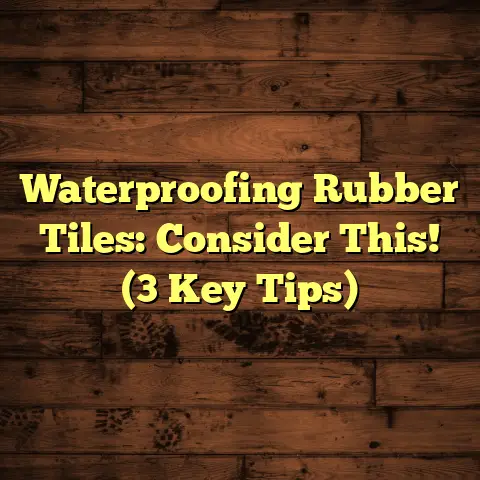Epoxy Floor Coatings: Price Guide? (7 Costly Mistakes)
As a flooring contractor for over 15 years,
I’ve seen firsthand the incredible versatility
of epoxy.
It’s not just for garages anymore!
We’re talking basements, kitchens, warehouses,
retail spaces—you name it.
Epoxy can transform
a space, adding durability and serious style.
But let’s be real, nobody wants a flooring
project to turn into a money pit.
So, let’s
talk about navigating the cost of epoxy flooring.
I’ll guide you through the factors that affect pricing and highlight seven costly mistakes I’ve witnessed time and time again.
Trust me, avoiding these pitfalls can save you
a ton of cash and heartache in the long run.
Ready?
Let’s get started!
Understanding Epoxy Floor Coatings
First, let’s break down what epoxy floor
coatings actually are.
At its core, it’s
a two-part system: epoxy resin and hardener.
When these two components mix, a chemical reaction occurs, creating a rigid, durable, and chemical-resistant surface.
Think of it like super-powered paint, but way tougher.
Benefits Galore
Why choose epoxy? The benefits are numerous:
Durability: Epoxy can withstand heavy foot traffic, impacts, and abrasions. I’ve seen it hold up in auto shops and factories for years.
Chemical Resistance: Spills happen, right? Epoxy resists oils, solvents, acids, and more. Perfect for garages and labs.
Easy Maintenance: Cleaning is a breeze. A simple mop and some mild detergent will keep your epoxy floor looking fantastic.
Aesthetics: Epoxy isn’t just practical; it can be beautiful. You can choose from a wide range of colors, patterns, and finishes.
Types of Epoxy
Not all epoxy is created equal. Here’s a quick rundown of the common types:
Solid Epoxy: This is the heavy-duty stuff. It’s typically 100% solids, meaning it has no solvents. It’s durable, but can be tricky to install.
Water-Based Epoxy: These are lower in VOCs (volatile organic compounds) and easier to apply. They’re a good option for residential projects.
100% Solids Epoxy: As I mentioned, this is super durable and great for industrial use. It releases almost no odor during application.
Epoxy Mortar: This is a mix of epoxy and graded aggregates. It’s used to repair cracks and damaged concrete before applying the final epoxy coating.
The Factors Influencing Epoxy
Flooring Prices
Okay, let’s talk money.
The price of epoxy
flooring can vary significantly based on
several factors.
Here’s what to keep in mind:
Material Costs
The type and quality of epoxy you choose will
significantly impact the price.
100% solids
epoxy will be more expensive than water-based
epoxy.
Also, specialty additives like metallic pigments or anti-slip aggregates will add to the cost.
Labor Costs
Professional installation is almost always
recommended, especially for larger or more
complex projects.
Labor costs will vary based
on your location and the contractor’s experience.
DIY installation can save money upfront, but it’s risky if you don’t have the skills and equipment.
Surface Preparation
This is huge.
Proper surface preparation is
essential for a successful epoxy floor.
Grinding,
shot blasting, or acid etching may be required
to create a clean, porous surface for the epoxy
to bond to.
The more prep work needed, the higher the cost.
Size of the Area
This one’s obvious, right?
The larger the area,
the more materials and labor are required.
However, you might get a price break per square foot on larger projects.
Customization Options
Want a custom color, a metallic swirl, or a
decorative flake finish?
These customizations
will increase the price.
Geographic Location
Prices for epoxy flooring can vary significantly
depending on where you live.
Labor costs,
material availability, and market demand all
play a role.
Here’s an example:
I’m working on a project in California where material costs are about 15% higher than a similar project I did in Texas, mainly due to shipping and local regulations.
To give you a general idea, here’s a table outlining typical epoxy flooring costs:
Disclaimer: These are just averages. Get multiple quotes for your specific project.
Costly Mistake #1 – Skipping
Surface Preparation
Okay, let’s get into the mistakes. This is the biggest one I see.
I can’t stress this enough.
Proper surface
preparation is absolutely critical for a
successful epoxy floor.
Think of it like painting a wall.
Would you
just slap paint on a dirty, greasy surface?
Of course not!
The same applies to epoxy.
The concrete needs
to be clean, dry, and porous for the epoxy
to bond properly.
The Consequences
What happens if you skip or skimp on surface
prep?
Here are some potential issues:
Peeling: The epoxy won’t adhere properly and will start to peel away from the concrete. I’ve seen entire floors peel up within months because of poor prep.
Bubbling: Moisture trapped in the concrete can cause bubbles to form in the epoxy coating.
Cracking: If the concrete surface isn’t stable, cracks can telegraph through the epoxy.
The Right Way
What does proper surface preparation look like?
It depends on the condition of the concrete,
but it typically involves:
Cleaning: Removing all dirt, grease, oil, and contaminants.
Grinding or Shot Blasting: Creating a porous surface for the epoxy to bond to.
Repairing Cracks and Damage: Filling in any cracks or holes in the concrete.
Profiling: Making sure the concrete is not too smooth and has enough “tooth” for the epoxy to grab onto.
Here’s a real-world example:
I had a client who tried to save money by
skipping the grinding step.
Within a few months,
the epoxy started peeling up in large sheets.
They ended up having to pay twice – once for
the initial failed installation and again for
the proper preparation and re-application.
Ouch!
Costly Mistake #2 – Choosing the
Wrong Type of Epoxy
Remember those different types of epoxy I
mentioned earlier?
Choosing the wrong one can
be a costly mistake.
Each type of epoxy has its own strengths and weaknesses, and some are better suited for certain environments than others.
The Wrong Choice
What happens if you choose the wrong epoxy?
Premature Failure: The epoxy might not be able to withstand the demands of the environment, leading to cracking, peeling, or chipping.
Increased Maintenance Costs: You might have to spend more time and money on cleaning and repairs.
Safety Hazards: In some cases, using the wrong epoxy can create a safety hazard. For example, using a slippery epoxy in an area prone to spills.
Matching Epoxy to the Environment
Here are some examples of choosing the right epoxy for the job:
Garages: 100% solids epoxy is a good choice because it’s durable and resistant to chemicals like oil and gasoline.
Kitchens: Water-based epoxy is a good option because it’s low in VOCs and easy to clean.
Industrial Facilities: Epoxy mortar is often used to repair damaged concrete before applying a topcoat of 100% solids epoxy.
Here’s a story:
I consulted with a brewery that had installed
a standard epoxy coating in their bottling area.
The constant exposure to beer and cleaning
chemicals caused the epoxy to degrade quickly.
They ended up having to replace the entire floor with a chemical-resistant epoxy designed for food and beverage environments.
Costly Mistake #3 – Underestimating Installation Costs
It’s easy to focus on the cost of the epoxy
itself, but don’t underestimate the installation
costs.
Labor, tools, and other materials can
add up quickly.
Common Pitfalls
Here are some common pitfalls when estimating installation costs:
Underestimating Labor: DIY projects often take longer than expected, and you might need to rent or buy specialized tools.
Forgetting Materials: Don’t forget to factor in the cost of primers, sealers, patching compounds, and other necessary materials.
Unexpected Issues: You might encounter unexpected issues during the installation, such as hidden damage to the concrete or difficult-to-remove coatings.
DIY vs. Professional
DIY installation can save money upfront, but it’s important to be realistic about your skills and experience.
If you’re not comfortable with the process,
it’s best to hire a professional.
A botched
DIY job can end up costing you more in the
long run.
Think of it this way:
Imagine trying to replace your car’s engine
without any experience.
You might save money
on labor, but you could also damage the engine
or injure yourself.
The same applies to epoxy flooring.
If you’re
not careful, you could end up with a floor
that looks terrible and doesn’t last.
Costly Mistake #4 – Ignoring Local
Regulations and Codes
Did you know that some areas have regulations
regarding flooring materials and installations?
Ignoring these regulations can lead to fines,
rework, or even having to replace your floor.
What to Look For
Here are some things to keep in mind:
VOC Regulations: Some areas have strict regulations on the amount of VOCs that can be emitted from flooring materials. Make sure to choose an epoxy that complies with these regulations.
Building Codes: Local building codes might specify requirements for flooring in certain types of buildings, such as hospitals or schools.
Permits: You might need to obtain a permit before installing epoxy flooring, especially in commercial buildings.
The Consequences
Failing to comply with local regulations can have serious consequences:
Fines: You could be fined for using non-compliant materials or for installing flooring without a permit.
Rework: You might have to remove the non-compliant flooring and replace it with a compliant material.
Legal Issues: In some cases, you could face legal action for violating local regulations.
Here’s a personal story:
I worked with a client who installed an epoxy
floor in their restaurant without obtaining a
permit.
The city inspector shut down the
restaurant until they obtained the necessary
permits and made some modifications to the
flooring.
It was a costly and time-consuming
mistake.
Costly Mistake #5 – Overlooking Warranty Options
Warranties are your safety net.
They protect
you against defects in materials or workmanship.
But many people overlook the warranty options
or don’t understand what they cover.
Understanding Warranties
Here’s what you need to know about epoxy flooring warranties:
Material Warranties: These warranties cover defects in the epoxy itself. If the epoxy fails prematurely due to a manufacturing defect, the manufacturer will typically replace it.
Labor Warranties: These warranties cover defects in the installation. If the epoxy fails due to improper installation, the contractor will typically repair or replace it.
What Voids a Warranty?
Be aware that certain things can void your warranty:
Improper Maintenance: Failing to maintain the epoxy floor properly can void the warranty.
Abuse or Misuse: Using the epoxy floor in a way that it wasn’t intended for can void the warranty.
DIY Repairs: Attempting to repair the epoxy floor yourself can void the warranty.
Here’s what I always tell my clients:
“Read the fine print!
Understand what’s covered
and what’s not.
And always follow the
manufacturer’s recommendations for maintenance
and care.”
The Financial Implications
Overlooking warranty terms can have significant
financial implications.
If your epoxy floor
fails and you’re not covered by a warranty,
you’ll have to pay out of pocket for repairs
or replacement.
Costly Mistake #6 – Neglecting
Maintenance Requirements
Epoxy floors are durable, but they’re not
indestructible.
Neglecting maintenance can
shorten their lifespan and lead to costly
repairs.
Basic Maintenance
Here are some basic maintenance tips for epoxy floors:
Sweep Regularly: Sweep the floor regularly to remove dirt, dust, and debris.
Mop with Mild Detergent: Mop the floor with a mild detergent and water. Avoid using harsh chemicals or abrasive cleaners.
Clean Up Spills Immediately: Clean up spills immediately to prevent staining or damage.
Use Walk-Off Mats: Place walk-off mats at entrances to prevent dirt and debris from being tracked onto the epoxy floor.
The Long-Term Savings
Regular maintenance can extend the life of
your epoxy floor and save you money in the
long run.
By preventing damage and wear, you
can avoid costly repairs or replacement.
Here’s a good analogy:
Think of your car.
If you neglect to change
the oil or get regular tune-ups, you’ll
eventually have major problems.
The same
applies to epoxy flooring.
The Cost of Neglect
Neglecting maintenance can lead to:
Scratches and Abrasions: Dirt and debris can scratch and abrade the epoxy surface.
Staining: Spills can stain the epoxy if they’re not cleaned up promptly.
Peeling and Chipping: Neglecting maintenance can weaken the epoxy and make it more susceptible to peeling and chipping.
Costly Mistake #7 – Failing to Get Multiple Quotes
This is a simple one, but it’s often overlooked.
Always get multiple quotes from different
contractors before making a decision.
The Risks of Going with the Lowest Price
It’s tempting to go with the lowest price, but
that can be a risky move.
The cheapest contractor
might be cutting corners on materials or
workmanship.
What to Look For in a Quote
When comparing quotes, pay attention to:
Materials: What type of epoxy are they using? Is it a high-quality product
Surface Preparation: What steps will they take to prepare the surface
Warranty: What type of warranty do they offer?
Experience: How much experience do they have with epoxy flooring?
My advice?
Don’t just focus on the bottom line.
Consider
the overall value of the quote, including the
quality of materials, the experience of the
contractor, and the warranty.
Getting the Best Value
Getting multiple quotes allows you to:
Compare Prices: You can see how different contractors price their services.
Negotiate: You can use the quotes to negotiate a better price.
Find the Best Fit: You can find a contractor who understands your needs and can provide the best value for your money.
Conclusion: Making Informed Decisions
About Epoxy Flooring
So, there you have it – seven costly mistakes to avoid when it comes to epoxy floor coatings.
From skipping surface prep to neglecting maintenance, these pitfalls can turn your flooring project into a financial nightmare.
But don’t worry!
By understanding the costs
associated with epoxy flooring and being aware
of these common mistakes, you can make informed
decisions that will save you money and ensure
that your investment is sound.
Remember, epoxy flooring can be a fantastic
choice for a variety of spaces.
It’s durable,
versatile, and can add serious style to your
home or business.
Just do your homework, choose the right
contractor, and avoid these costly mistakes.
Your floors (and your wallet) will thank you!





